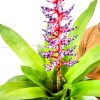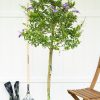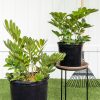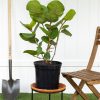Description
AN EASY CARE BROMELIAD THAT AMPS UP YOUR GARDEN WITH BLUE, PURPLE & PINKIf you’re looking for vibrant color and easy care, look no further than the ‘Del Mar’ Bromeliad. The ‘Blue Tango’s’ hypnotic blue and purple flowers on their hot pink spike light up a room and create a truly tropical mood.Outdoors, the Del Mar is well suited to grow in many different frost-free regions, preferring light shade or indirect sunlight. They also thrive indoors, even in office spaces with florescent lighting. The Del Mar is quite hardy, not susceptible to many pests.Because there is no stem to the plant, the leaves actually come together to form a type of rosette (commonly called a “tank”) to take in water. Keeping water in the central “tank” will keep the plant flourishing.Caring for your Dwarf Blue Tango BromeliadAechmea ‘Del Mar’ is a beautiful bromeliad hybrid known for its striking foliage and stunning flowers. This tropical plant can thrive both indoors and outdoors in warm, humid environments. Here’s everything you need to know to care for this unique plant:LightAechmea ‘Del Mar’ does best in bright, indirect light. This plant can handle a few hours of direct sunlight, but too much direct sunlight can scorch the leaves. When grown indoors, place the plant near a window that receives bright, filtered light. When grown outdoors, place it in a spot with partial shade. Avoid placing this plant in a location where it will receive direct sunlight during the hottest parts of the day.WaterAechmea ‘Del Mar’ requires consistently moist soil. However, it’s important not to overwater the plant, as this can lead to root rot. When watering, pour water into the rosette formed by the leaves and also water the soil. It’s essential to keep the central rosette filled with water at all times, as this is where the plant gets most of its moisture. However, make sure not to let the water pool in the rosette for too long, as this can lead to rot.HumidityThis bromeliad is native to tropical areas, so it requires high humidity levels to thrive. If you live in a dry climate, consider using a humidifier or placing a tray of water near the plant to increase humidity. You can also mist the plant regularly to provide additional moisture.SoilAechmea ‘Del Mar’ requires well-draining soil to prevent water from accumulating around the roots. A mixture of potting soil and perlite or sand works well for this plant. Make sure to plant the bromeliad in a pot with drainage holes to prevent water from pooling in the soil.FertilizerAechmea ‘Del Mar’ benefits from regular fertilization during the growing season. Use a balanced fertilizer every two to three weeks during the spring and summer months. However, make sure not to fertilize the plant during the winter months when it goes dormant.PropagationAechmea ‘Del Mar’ can be propagated through offsets, which are small plants that grow off the mother plant. To propagate the plant, wait until the offset is at least a third the size of the mother plant, then remove it from the main plant with a sharp, clean knife. Plant the offset in a pot with well-draining soil, and keep it moist until it establishes roots.PruningPruning is not necessary for Aechmea ‘Del Mar’. However, it’s a good idea to remove any dead or dying leaves to keep the plant looking its best. To remove dead leaves, gently pull them away from the plant.Pest and Disease ControlAechmea ‘Del Mar’ is generally a healthy plant that’s resistant to pests and diseases. However, like all plants, it can be susceptible to issues such as spider mites, mealybugs, and scale insects. If you notice signs of pests, such as sticky residue on the leaves or white webbing, treat the plant with a mild insecticide.In terms of diseases, the most common issue that can affect Aechmea ‘Del Mar’ is root rot, which occurs when the soil is too wet.





